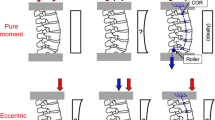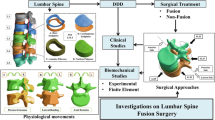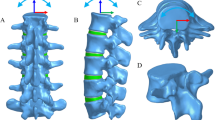Abstract
Total disk replacement (TDR) has met considerable reluctance from the medical community, mainly in the United States, because the insurance companies have refused to reimburse surgeons for fear of delayed complications, revisions and unknown secondary costs. Typical long-term vertebrae-implant related structural complications include subsidence, migration, implant displacement, endplate fracture, wear and loosening. Intervertebral disc implant size, shape, position, endplate removal and compressive strength of trabecular bone further affect the risk of implant subsidence and loosening. The aim of the present study is to understand the combined effects of the different depth positioning of the ProDisc-L implant and endplate removal during surgery on the vertebral bone strain behaviour. Manufactured synthetic spinal L3-L4 segments were used to experimentally predict vertebrae cortex strain behaviour for different depth implant positioning and endplate thickness removal. In addition, validated finite element models were developed to assess the structural behaviour of cancellous-bone. Measured cortex strains showed significant differences relative to the intact vertebra for the most extreme depth implant positioning. The endplate thickness reduction tends to decrease significantly compressive cortex strains for all strain gauges. A two- to three-fold cancellous-bone strain increase occurs when more than 50% of the endplate thickness is removed, independently of the depth implant position. It is concluded that the implanted strain distribution that better fits intact vertebra strain behaviour is achieved when the depth centred implant position is combined with a partial endplate thickness removal.





Similar content being viewed by others
References
Sandhu F, Blumenthal S, Grunch B, Kimball B, Ferko N, Hollmann S (2017) Barriers to and budget impact of lumbar Total disc replacement utilization. Spine. 42(Suppl 24):S112–S114
Hart RA, DePasse JM, Daniels AH (2017) Failure to launch: what the rejection of lumbar Total disk replacement tells us about American spine surgery. Clin Spine Surg 30:E759–E764
Siepe CJ, Heider F, Wiechert K, Hitzl W, Ishak B, Mayer MH (2014) Mid- to long-term results of total lumbar disc replacement: a prospective analysis with 5- to 10-year follow-up. Spine J 14:1417–1431
Garcia R Jr, Yue JJ, Blumenthal S, Coric D, Patel VV, Leary SP, Dinh DH, Buttermann GR, Deutsch H, Girardi F, Billys J, Miller LE (2015) Lumbar Total disc replacement for Discogenic low Back pain: two-year outcomes of the activL multicenter randomized controlled IDE clinical trial. Spine. 40:1873–1881
Salzmann SN, Plais N, Shue J, Girardi FP (2017) Lumbar disc replacement surgery-successes and obstacles to widespread adoption. Curr Rev Musculoskelet Med 10:153–159
Formica M, Divano S, Cavagnaro L, Basso M, Zanirato A, Formica C, Felli L (2017) Lumbar total disc arthroplasty: outdated surgery or here to stay procedure? A systematic review of current literature. J Orthop Traumatol 18:197–215
Lee CK (2007) Osteopenia and total disc prosthesis subsidence: inclusion/exclusion criteria for total disc replacement. SAS J 1:82–84
Auerbach JD, Ballester CM, Hammond F, Carine ET, Balderston RA, Elliott DM (2010) The effect of implant size and device keel on vertebral compression properties in lumbar total disc replacement. Spine J 10:333–340
Oxland TR, Grant JP, Dvorak MF, Fisher CG (2003) Effects of endplate removal on the structural properties of the lower lumbar vertebral bodies. Spine 28:771–777
Zigler J, Garcia R (2015) ISASS policy statement - lumbar artificial disc. Int J Spine Surg 9:7
Osterhoff G, Morgan EF, Shefelbine SJ, Karim L, McNamara LM, Augat P (2016) Bone mechanical properties and changes with osteoporosis. Injury. 47:S11–S20
Zhou SH, McCarthy ID, McGregor AH, Coombs RR, Hughes SP (2000) Geometrical dimensions of the lower lumbar vertebrae--analysis of data from digitised CT images. Eur Spine J 9:242–248
Saraste H, Brostrom LA, Aparisi T, Axdorph G (1985) Radiographic measurement of the lumbar spine – a clinical and experimental study on man. Spine 10:236–241
Kemper AR, McNally C, Duma SM (2007) The influence of strain rate on the compressive stiffness properties of human lumbar intervertebral discs. Biomed Sci Instrum 43:176–181
Smeathers JE, Joanes DN (1988) Dynamic compressive properties of human lumbar intervertebral joints: a comparison between fresh and thawed specimens. J Biomech 21:425–433
ASTM F2423-11 (2016) Standard guide for functional, kinematic, and Wear assessment of Total disc prostheses. ASTM International, West Conshohocken, PA
Prodisc-L (2017) Modular intervertebral disc prosthesis for stabilizing the lumbar spine and restoring the physiological range of motion – surgical technique DePuy Synthes Spine, a division of Synthes GmbH
Completo A, Nascimento A, Ramos A, Simões J (2015) Failure analysis of C-5 after total disc replacement with ProDisc-C at 1 and 2 levels and in combination with a fusion cage: finite-element and biomechanical models. J Neurosurg Spine 22:639–646
Polikeit A, Ferguson SJ, Nolte LP, Orr TE (2003) Factors influencing stresses in the lumbar spine after the insertion of intervertebral cages: finite element analysis. Eur Spine J 12:413–420
Goreham-Voss CM, Hyde PJ, Hall RM, Fisher J, Brown TD (2010) Cross-shear implementation in sliding-distance-coupled finite element analysis of wear in metal-on-polyethylene total joint arthroplasty: intervertebral total disc replacement as an illustrative application. J Biomech 43:1674–1681
Completo A, Simões J, Fonseca F (2008) Experimental evaluation of strain shielding in distal femur in revision TKA. Exp Mech 48:817–824
Completo A, Fonseca F, Simões JA, Ramos A, Relvas C (2012) A new press-fit stem concept to reduce the risk of end-of-stem pain at revision TKA: a pre-clinical study. Knee 19:537–542
Pentecost R, Murray R, Brindley H Fatigue (1964) insufficiency, and pathological fractures. JAMA. 187:1001–1004
Lambers F, Bouman A, Rimnac C, Hernandez C (2013) Microdamage caused by fatigue loading in human cancellous bone: relationship to reductions in bone biomechanical performance. PLoS One 8:e83662
Frost H (2003) Bone's mechanostat: a 2003 update. Anat Rec A Discov Mol Cell Evol Biol 275:1081–1101
Heiner A (2008) Structural properties of fourth-generation composite femurs and tibias. J Biomech 41:3282–3284
Completo A, Duarte R, Fonseca F, Simões JA, Ramos A, Relvas C (2013) Biomechanical evaluation of different reconstructive techniques of proximal tibia in revision total knee arthroplasty: an in-vitro and finite element analysis. Clin Biomech 28:291–298
Eswaran SK, Gupta A, Adams MF, Keaveny TM (2006) Cortical and trabecular load sharing in the human vertebral body. J Bone Miner Res 21:307–314
Ferguson SJ, Steffen T (2003) Biomechanics of the aging spine. Eur Spine J 12(Suppl 2):S97–S103
Kerner J, Huiskes R, van Lenthe GH, Weinans H, van Rietbergen B, Engh CA, Amis AA (1999) Correlation between pre-operative periprosthetic bone density and post-operative bone loss in THA can be explained by strain-adaptive remodelling. J Biomech 32:695–703
Gross T, Rubin C (1995) Uniformity of resorptive bone loss induced by disuse. J Orthop Res 13:708–714
Taylor M, Tanner K (1997) Fatigue failure of cancellous bone: a possible cause of implant migration and loosening. J-Bone-Joint-Surg Br 79:181–182
Choi K, Goldstein SA (1992) A comparison of the fatigue behavior of human trabecular and cortical bone tissue. J Biomech 25:1371–1381
Hongo M, Abe E, Shimada Y, Murai H, Ishikawa N, Sato K (1999) Surface strain distribution on thoracic and lumbar vertebrae under axial compression. The role in burst fractures. Spine. 24:1197–1202
Shah JS, Hampson WG, Jayson MI (1978) The distribution of surface strain in the cadaveric lumbar spine. J Bone Joint Surg Br 60:246–251
Cristofolini L, Brandolini N, Danesi V, Juszczyk MM, Erani P, Viceconti M (2013) Strain distribution in the lumbar vertebrae under different loading configurations. Spine J 13:1281–1292
Pollintine P, Dolan P, Tobias JH, Adams MA (2004) Intervertebral disc degeneration can lead to "stress-shielding" of the anterior vertebral body: a cause of osteoporotic vertebral fracture? Spine. 29:774–782
Acknowledgements
The authors acknowledge the financial support through project POCI-01-0145-FEDER-028424, which was funded by the Operational Program for Competiveness and Internationalization (COMPETE 2020) in its component FEDER and by Science and Technology Foundation (FCT) through the OE budget. The authors also acknowledge FCT grant UID/EMS/00481/2019–FCT and the infrastructures support CENTRO-01-0145-FEDER-022083-Centro Portugal Regional Operational Programme (Centro2020).
Author information
Authors and Affiliations
Corresponding author
Additional information
Publisher’s Note
Springer Nature remains neutral with regard to jurisdictional claims in published maps and institutional affiliations.
Rights and permissions
About this article
Cite this article
Semitela, A., Fonseca, F. & Completo, A. Experimental Evaluation of Vertebral Strain in Lumbar Total Disc Replacement. Exp Mech 60, 119–128 (2020). https://doi.org/10.1007/s11340-019-00545-9
Received:
Accepted:
Published:
Issue Date:
DOI: https://doi.org/10.1007/s11340-019-00545-9




